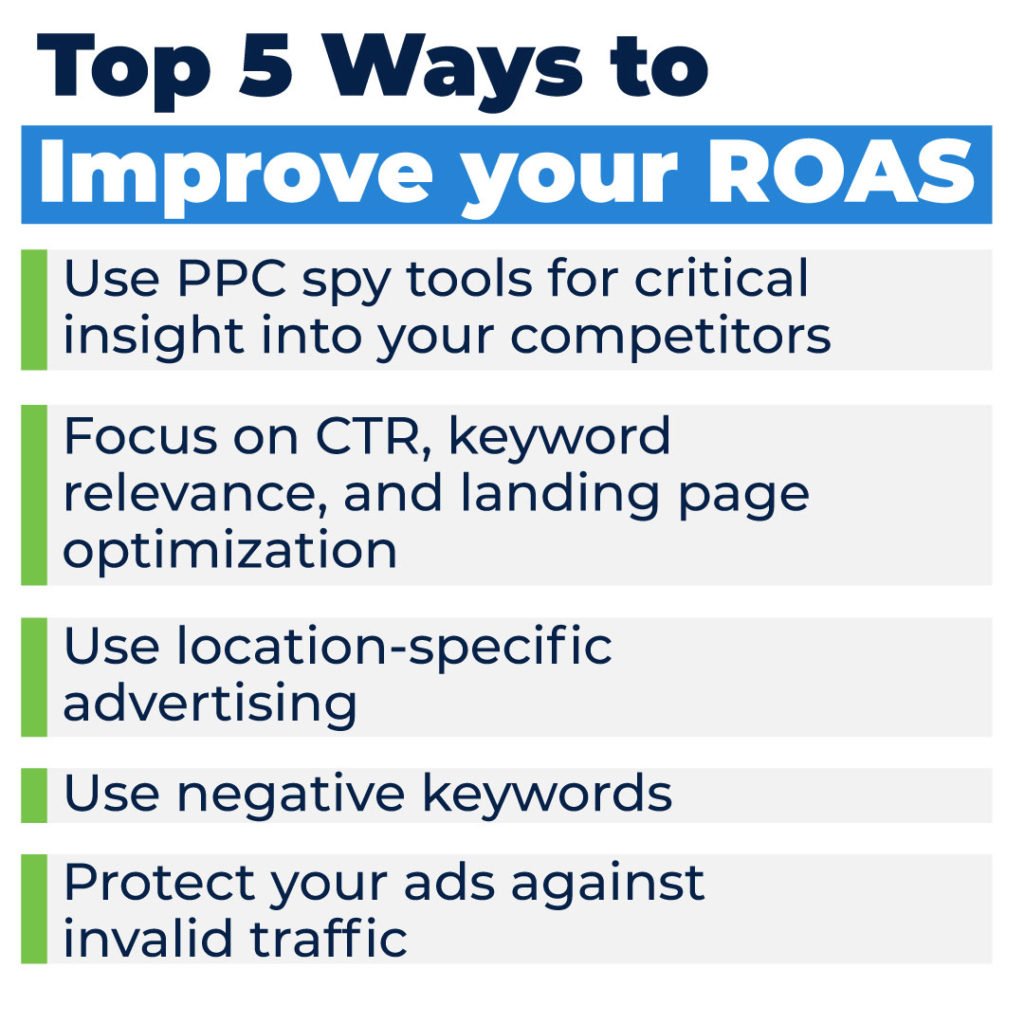As a digital marketer or entrepreneur, you know that ads are the driving force behind getting your business in front of customers and generating revenue. Determining the effectiveness of your paid adverts is crucial for sustaining your business, which is why marketing metrics like Return on Ad Spend (often referred to as ROAS) are so awesome.
But it’s not an easy task to run effective campaigns out there in the digital space. Beyond the difficulties of running successful ads that boost traffic and revenue, digital marketers and business owners are also at risk of becoming victims of budget-depleting practices like click fraud.
So, how do you maximize Return on Ad Spend and protect your ad campaigns from fraud to keep building that business of yours? Keep reading for an overview of how to calculate ROAS and five smart strategies you can implement to improve your ROAS.
What Is Return on Ad Spend and How is it Calculated?
Return on Ad Spend is a marketing metric that measures the financial return of your advertising campaign. To measure ROAS simply divide the total generated revenue from your ad strategy or campaign by its total cost.
For example, if I spent $5,000 on PPC ads this month and my campaign resulted in $20,000 in revenue, my ROAS is 4:1 (or $4). What constitutes a good ROAS depends on different factors for you and your business, but most companies aim for a 4:1 ratio.
It sounds simple, but ROAS is a critical tool that provides insight into what works and what doesn’t so you can determine which strategies you should keep (or drop). Clicks on ads and website visits are great, but revenue is the goal.
You can read more in-depth about calculating your return on ad spend and how Google uses it in several of our other blog posts and webinars. In this piece we’ll dive into the most effective strategies to maximize your Return on Ad Spend.
Become A Spy
This is your chance to do the sneaky spy stuff you’ve always wanted to do. Spying on your competition will give you vital information about long-term trends that work, allowing you to adopt high-performing strategies and save time and money.
There are a ton of pay-per-click (PPC) spy tools you can use to see what’s working (and what’s not) for your competitors, which is a huge advantage for you as an advertiser or entrepreneur and an effective way to maximize your Return on Ad Spend.
Midas Media identified the three major things you should look for when spying:
- Which keywords are your competitors bidding on the most?
- Are you bidding on keywords that no one else is using?
- What copy is your competition using?
- Does your competition use stand-out offers you could also use?
Maximizing your Return on Ad Spend depends on two factors – generating more revenue and lowering ad costs. Learning what strategies successful competition uses is like discovering a gold mine. By implementing some of these strategies, you have the potential to both lower your ad costs by avoiding the wrong keywords and increase revenue by plugging into the right keywords, offers, and copy examples.
Becoming a digital advertising spy is truly an effective, strategic, and indispensable way to maximize your Return on Ad Spend.
Improve Your Quality Score
Google’s Quality Score measures whether an ad is relevant for the keywords it is targeting. The better your quality score, the lower your cost-per-click and the higher your ads rank. With higher ad ranking comes a reduction in wasted ad spend and, overall, a superior Return on Ad Spend.
Google calculates your quality score primarily through click-through rates, keyword relevance, and if your landing page is optimized. Specific and targeted keywords that match your website content will bring in your ideal customers and improve your quality score. To improve landing page user experience, make sure your landing pages feature the content your ads are promoting.
Improving your Google Ads Quality Score will pay off with a boost to your Return on Ad Spend.
Target Your Ads with Geotargeting
Geotargeting, or local PPC, delivers different content to customers based on their geolocation. Use geotargeting if your business is brick-and-mortar, a restaurant or food delivery, or if your eCommerce site can only ship to certain locations to avoid advertising to customers that are not within your store’s radius.
Google Ads offers a way to target your ads to geographic locations of your choice, which helps focus your advertising to the right customers for your business.
To effectively use geotargeting, you’ll need to target location-specific keywords, ensure your landing pages reflect the customer’s location and needs, and exclude locations that are not within your customer/business range.
Taking advantage of geotargeting can help maximize your Return on Ad Spend by cutting out the wrong clicks on your ads and putting your business in front of your ideal audience.
Use Negative Keywords
Using the wrong – and too many – keywords is a common budget-wasting problem. Many advertisers are using more keywords than they need to use, and squandering up to 61% of their ad spend.
To maximize your Return on Ad Spend, you can use the negative keyword feature to lower your ad costs.
First review your keywords to see if some are getting clicks but not resulting in any conversion – these keywords are harming your budget. Then, create a negative keywords list made up of irrelevant and useless keywords to avoid paying for clicks that don’t convert to sales.
(Click)Guard Your Ads
Manipulation in the form of click fraud, click farms, fake followers, and buying “likes” to artificially boost engagement and harm competitors are shadowy practices becoming more commonplace, causing confusion for digital marketers about what’s really happening in the online space and hijacking advertising campaigns.
If a company hasn’t set up protections against click fraud, competitors can continually click on pay-per-click ads until the PPC daily budget is depleted, preventing real customers from viewing them. If you aren’t guarding your ads, maximizing your Return on Ad Spend will be tough. It’s likely that you have already encountered some form of click fraud.
Click fraud affects businesses and advertisers by:
1) distorting ad campaign metrics so it’s challenging to tell whether campaigns are effective;
2) leading to ineffective campaigns with low ROAS; and
3) wasting internal time and effort by causing teams to chase non-revenue generating activities.
Click fraud takes many forms, including viewbotting, fake streaming, ad injection, and PPC phishing. Each of these fraudulent practices can do a lot of damage to your Return on Ad Spend. It’s worse than you might think – marketers lose billions every year because of click fraud.
As an online marketer or entrepreneur, you can protect your business from this digitized ad-budget weapon by using an anti-click fraud protection program. A trusted anti-fraud partner like ClickGuard will wipe out fraudulent activity in the form of fake clicks by monitoring and blocking click fraud threats, protecting your PPC ads and campaigns and your Return on Ad Spend.
Conclusion
To sum up, the five smart strategies you should implement to improve your Return on Ad Spend are:

A healthy Return on Ad Spend comes down to one key question: Are my ads generating enough revenue to take care of themselves? What constitutes a good ROAS varies by industry, campaigns, and overall goals, but this is the first critical thing to determine. Your ad campaign shouldn’t be depleting your resources; rather, it should be driving traffic, boosting sales, and contributing to the overall health and sustainability of your business.
Ultimately, maximizing your Return on Ad Spend comes down to two basic things: lowering the cost of your ads and boosting the revenue your ads generate. Simple in theory, but much more difficult in practice. Using these five strategies will keep you ahead of the curve and running a successful, lucrative ad campaign so your business can provide value to customers and thrive.



